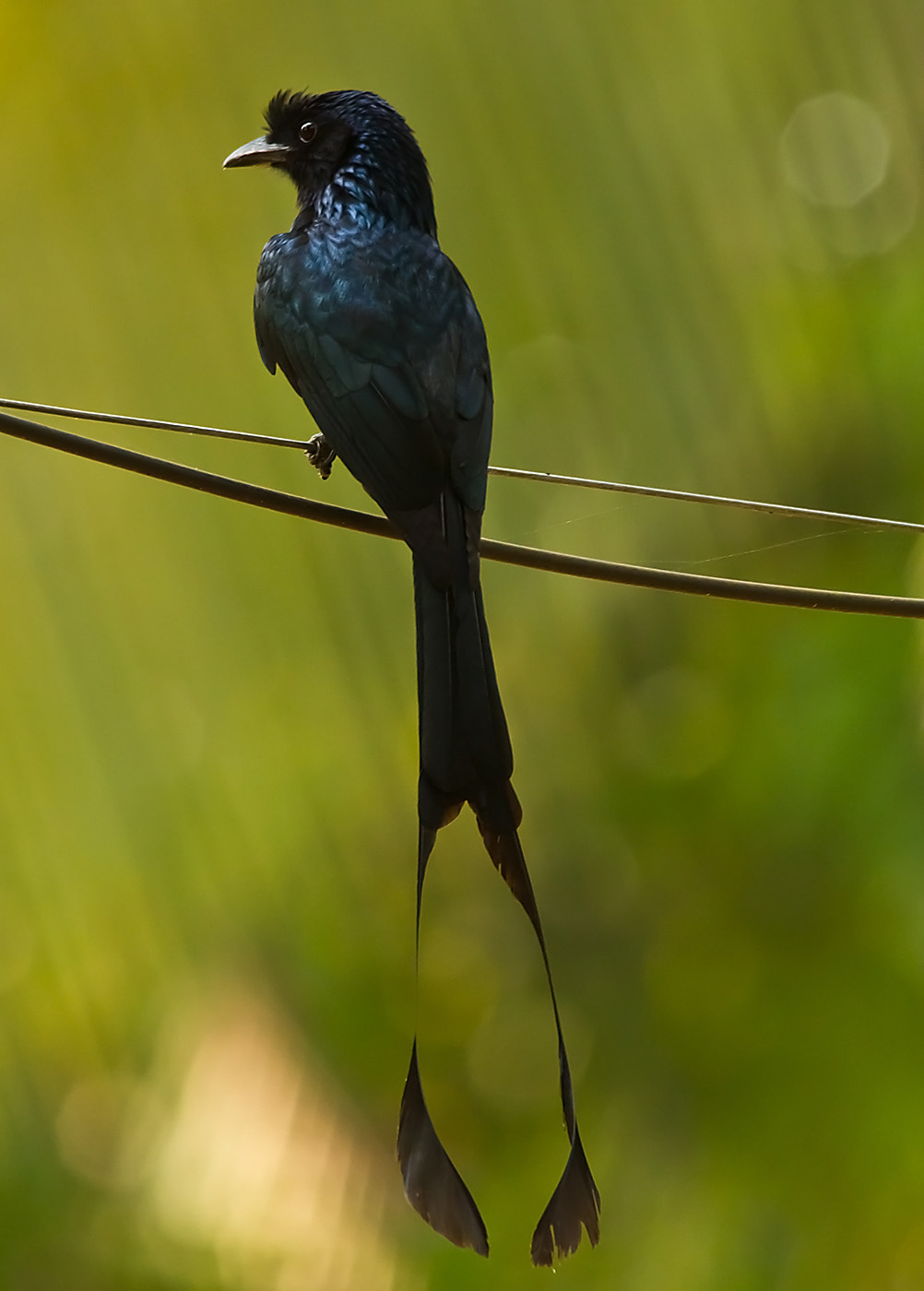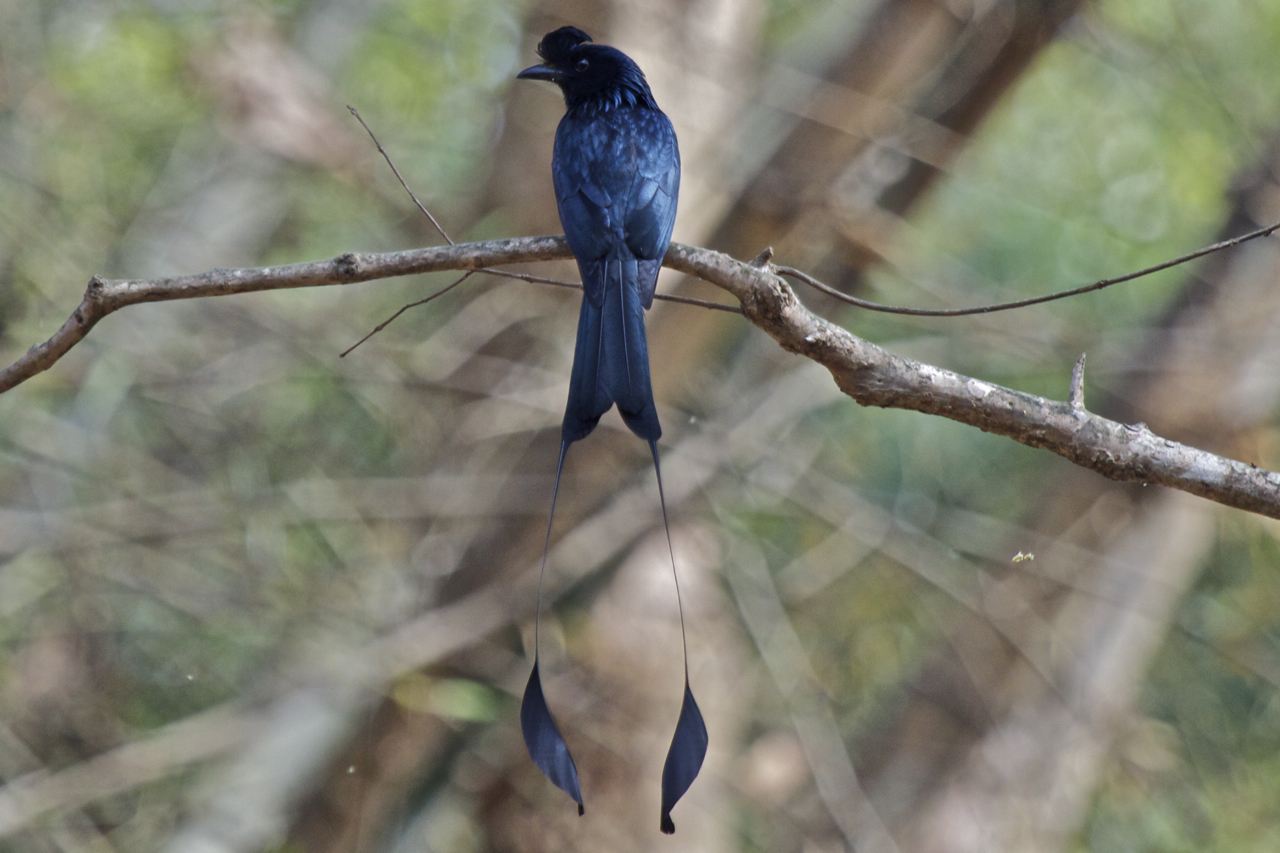
Dicrurus paradiseus
TAXONOMY
Cuculus paradiseus Linnaeus, 1766, “Siam” = region between
Ayuthia and Gulf of Thailand. About 14 subspecies, differing
principally in size and presence and form of crest and tail
rackets.
OTHER COMMON NAMES
English: Large racket-tailed drongo; French: Drongo а raquettes;
German: Flaggendrongo; Spanish: Drogo de Cola Raqueta
Grande.
PHYSICAL CHARACTERISTICS
13–14 in (33–36 cm), excluding rackets; 2.5–4.4 oz (70–125 g).
Most extravagantly plumed drongo, red-eyed and all black
glossed bluish to greenish, with scaly-hackled mantle, a large
crest varying from forward-facing bristles to, usually, webbed
plumes curving back over crown in a mane, and an extraordinary
tail with two outer racket-tipped streamers that, of variable
form, are often bare of webbing except for short, twisted
spoon-shaped vanes at tips; sexes similar but immatures dull and
brown-eyed with vestigial crests and shortened tail streamers.
DISTRIBUTION
Lowland Southeast Asia, locally to 4,900 ft (1,500 m) above sea
level, from India and Sri Lanka north to south Himalayas, and
east to all Southeast Asia south of south China (Yunnan,
Hainan Island) and north Vietnam, and throughout Greater
Sundas and archipelagos in the Bay of Bengal.
HABITAT
Open interior and edges of evergreen and deciduous forests,
including rainforests, and taller close woodlands, from sea-level
to 4,900 ft (1,500 m); also plantations, garden edges, and open
secondary growth.
BEHAVIOR
Either solitary, in pairs or small family groups, greater rackettailed
drongos are resident and territorial throughout their
range. They commonly associate with foraging bands of mixed
bird species, perching on exposed branches in and on the edge
of forest mid-strata and sallying forth on wing. Flight is buoyant
and dipping, of rapid flapping then gliding, the tail streamers
making a distinctive humming. Racket-tails are extrovertly
noisy, often displaying and counter-singing in small groups,
and are one of the first and last birds stirring at dawn and
dusk. They have a lusty repertoire of resonant warbles, whistles,
and bell-like notes, mixed with typically drongo-like dry
chatterings and metallic twanging; mimicry is also a feature.
FEEDING ECOLOGY AND DIET
Hawks, like other drongos, catching prey in mid-air or from
vegetation surfaces and often carrying it in its claws to a perch
for dismembering. Diet comprises mainly a range of large flying
insects (termites, moths, beetles, dragonflies, ants, bees, locusts,
and mantids); nectar is an important supplement.
REPRODUCTIVE BIOLOGY
Breeds over summer (June–July) in northern parts of range,
but earlier from winter (February) in the low tropics. Nest a
deep, loose cup, 5.9 in diameter x 1.9 in deep (15 cm x 5 cm),
DISTRIBUTION
Southeast Iran and south Afghanistan through south Himalayas
to all India, Sri Lanka and mainland Southeast Asia north
through central and east China to Formosa and south
Manchuria, at altitudes from sea level to 6,600 ft (2,000 m);
also an outlying population on Java and Bali.
HABITAT
Savannas, fields, and urban habitats outside forest, in more
open environments than occupied by other drongos; over
much of its range the black drongo has become a commensal
of man.
BEHAVIOR
Thrives in open habitat, seeking exposed vantage perches in
isolated trees, fence posts, tops of banks, buildings, and electric
wires and poles, and sallying out from them on wing in buoyant,
acrobatic evolutions. Tropical populations are resident but
opportunistically nomadic out of breeding, and more temperate
populations north through China are strongly migratory. This
species is more social than other drongos, particularly out of
breeding and may roost in flocks, dispersing at dawn to respective
feeding territories. It is also especially pugnacious and
fearless in defending feeding and breeding territory from
larger, predatorial birds. Calls comprise a variety of harsh
metallic chatterings; in apparent courtship, pairs or competitive
trios perch close or face to face duetting or counter-singing in
harsh scolding notes accompanied by violent up-and-down
head-bowing and wing fluttering aerial chases.
FEEDING ECOLOGY AND DIET
An opportunistic aerial insectivore, congregating loosely at concentrations
of food and environmental disturbances that flush it,
such as fire, grazing domestic stock, field clearing, and ploughing.
Black drongos even chase other birds piratically for captured
prey, and will sometimes settle on the ground to pick up ants and
emerging termites. Their staple diet comprises a range of large,
hard-cased field insects—locusts and crickets, beetles, and bees—
and also some moths and butterflies and, infrequently, small reptiles,
birds, and bats. Nectar is an important supplement, and the
drongos may play a useful role in plant pollination.
REPRODUCTIVE BIOLOGY
Breeds from February to August, earlier in the tropics and
later in more temperate regions, coincident with peaks in insect
activity. Nest a flimsy saucer of twigs, grass, and fiber, cemented
and bound with cobweb to a horizontal fork at end of
a branch about 13–39 ft (4–12 m) above the ground, commonly
in an isolated tree with clear view of surroundings.
Eggs, in clutches of 2–5, are 0.8–1.1 x 0.7–0.8 in (20–28 x
18–20 mm), whitish to pinkish cream and spotted and blotched
with reddish brown and black. Nests are often parasitized by
cuckoos, e.g., Surniculus lugubris and Eudynamys scolopacea.
CONSERVATION STATUS
Not threatened.
SIGNIFICANCE TO HUMANS
None known.
Other popular Animals
Photo Gallery of - Greater racket-tailed drongo




 Animalia Life
Animalia Life